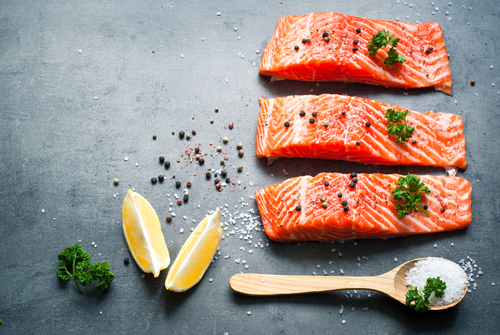By now you probably know that eating fish a few times a week is great for your health. Not only is fish an excellent source of protein, it also offers a host of vitamins and minerals. And, cold water oily fish are rich in omega-3 fatty acids, which are incredibly important for optimal health.
Omega-3s have been shown to lower blood pressure and triglycerides, which make them a powerful agent against cardiovascular. And, with their ability to fight inflammation, omega-3s can lessen your risk for a variety of chronic diseases.
But omega-3s benefits don’t stop there. They have also been linked with eliminating the symptoms of arthritis and depression. DHA, specifically, is beneficial for the human brain, especially in the healthy brain development of infants and young children. Ensuring children have DHA in their diet has resulted in better cognitive performance, while a lack of it is associated with learning disabilities.
When it comes time to choosing a fish it gets a little tricky, because fish high in omega-3 fatty acids can also contain high levels of mercury and other contaminants. Also, certain fish are caught in more ethical and environmentally sustainable ways than others.
The following is a list of great choices, and not so great choices, when it comes to buying and eating fish.
4 Fish to Eat
Wild-caught, Alaskan salmon
This fish tops my list because it is high in omega-3s, low in mercury and other contaminants, and is fished using sustainable practices that are closely monitored, as is the quality of the water these fish live in.
Salmon is also so easy to prepare – sear it for a few minutes on each side in a nice hot pan, or grill it with a nice big salad on the side.
Wild-caught, Pacific sardines
Before you roll your eyes at the mere mention of sardines, consider the fact these fish have more omega-3 content per serving than both salmon and tuna! Also, because of their small size and their low position on the sea food chain, they haven’t lived long enough to build up any mercury in their system. Also, because they reproduce very quickly, there is very little concern that their population will ever be threatened.
A little chopped-up sardine is the perfect addition to many salads.
Wild-caught, Alaskan halibut
This next fish is also high in omega-3s, low in contaminants and caught using sustainable practices. Wild halibut fishing causes minimal damage to their habitats and ensures there is a low risk of accidentally hurting other sea creatures.
Talk about versatility, this fish can be baked, broiled, poached or grilled. Yum!
Farmed rainbow trout
This is a fish that is actually healthier when it’s farmed and not caught in the wild. Trout caught in lakes can be full of contaminants. Think about all of those boats leaking gasoline into the water! Farmed trout are raised in freshwater ponds that are protected from contaminants. These trout are also fed a special diet that helps them be high in omega-3s.
[Editor’s note: A few family members absolutely hate the taste of fish, instead, they take Ultra Pure omega-3 supplement. It’s pure, potent, and tastes great (no fishy taste at all). Click Here to pick up a FREE bottle on us today!]
4 to Avoid
Now let’s talk about some fish you should do your best to avoid.
Farmed salmon
When you buy salmon at the grocery store, either fresh or frozen, it’s incredibly important to know whether it’s wild or farmed. Farmed salmon is often labeled ‘Atlantic salmon’ so read the bag or ask the person behind the counter. If they don’t know, don’t buy it.
The reason farmed salmon is so unhealthy is because these fish are crammed into small pens where disease and parasites can easily spread. To solve this dilemma, the salmon are dosed with antibiotics. Guess where those antibiotics end up when you eat these fish?
Farmed salmon have also been found to contain high levels of polychlorinated biphenyls (PCBs). These industrial chemicals were actually banned in the United States back in the late 70s, but they are still very much present in our environment. PCBs have been linked to certain cancers and are damaging to the nervous, endocrine, and reproductive systems.
Bluefin tuna
This is another fish that has been found to contain high levels of PCBs as well as mercury. On top of this, Bluefin is considered a threatened species and fishing them is dangerous to their survival.
Chilean sea bass
You often see these fish on the menu at seafood restaurants (or any restaurant for that matter) but do NOT order one. They are high in mercury and fishing them causes damage to the ocean floor. It can also be destructive to seabirds, as they often get tangled in the trawlers.
Imported catfish
It’s always risky to eat any kind of imported food as the safety regulations are vastly different from country to country. Much of the catfish eaten in the US is imported from Vietnam, where it is often treated with antibiotics, including certain antibiotics that have been banned in this country. To add insult to injury, these fish are not always inspected properly, which makes eating them very hazardous.
There’s no doubt that fish is delicious and can be tremendously good for our health. But it’s important to choose wisely in order to protect yourself and your family from dangerous contaminants, as well as to preserve our beautiful environment.
 Validating...
Validating... 






2 Comments